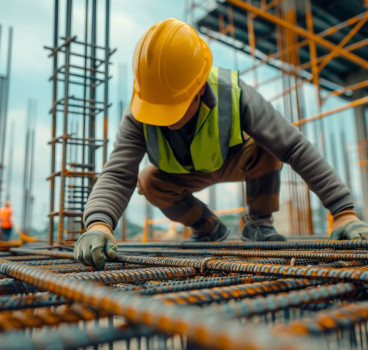Construction and the beauty in what’s meant to disappear
Every city skyline is a work in progress. Cranes etch temporary hieroglyphs across the horizon - scaffolds climb facades like steel vines - plywood hoardings cordon off the future from the present. For most passersby, these structures are visual noise or functional clutter masking the main event. Yet, look closer and they tell a deeper story about the craftsmanship, creativity and impermanence that define the built environment – and I make no apology about waxing poetic about their very existence, writes John Ridgeway.
When the scaffolding comes down, what’s left behind is not only the finished building, but the traces of a process that once made the invisible visible. Temporary works - the scaffolds, platforms, cranes and enclosures that support and protect construction, shape the character of our cities as profoundly as the finished projects they enable.
Scaffolding is often dismissed as a means to an end - an ugly necessity, tolerated until the “real” structure is revealed. But in truth, it’s architecture in its own right, a skeletal, evolving framework that reflects the rhythm of human effort. There’s a certain poetry to its geometry, a visual rhythm in the repetition of tubes, clips, and planks.
From the towering latticework of high-rise construction in London’s financial district to the dense, bamboo-framed towers of Hong Kong, scaffolding is the universal language of progress. It adapts to the needs of each site and evolves with it. Every beam and brace tell a story of collaboration between engineers, designers and the scaffolders whose artistry and precision make vertical ambition possible.
For a few fleeting months, or years, these temporary structures are the city’s true landmarks. They rise before the building does and disappear before the ribbon is cut. In between, they hold the weight of creation itself.
Hoardings as the city’s storyboards
Beyond the scaffold, site hoardings have become one of the most visible and versatile canvases in the urban landscape. What was once a blank barrier now tells stories, sells visions and softens disruption. They hide the dust and noise, but they also invite curiosity, offering glimpses of what’s to come.
Hoardings are where marketing, design, and community meet. They turn construction into conversation. A well-designed hoarding can transform a street’s atmosphere, injecting colour, context and anticipation where otherwise there might be frustration at yet another blocked pavement.
Increasingly, developers are realising their potential not just as advertising space, but as tools for engagement. They celebrate local artists, highlight sustainability goals, or showcase historical narratives about the area. The result? A once purely functional feature becomes part of the cultural texture of the city, a living, breathing billboard for the future.
The modern cathedrals of construction
If scaffolding is the architecture of support, then cranes are the architecture of ambition. They are the unmistakable silhouettes of change, the vertical punctuation marks that define a skyline in flux.
Each crane is a monument to precision engineering and human daring. Operators sit hundreds of feet above ground, commanding tonnes of steel and concrete with fingertip control. At night, their red lights blink like constellations above sleeping cities, a reminder that progress is perpetual.
Yet cranes, too, are temporary. They exist only for the duration of a project, vanishing as quietly as they appeared. When the last crane leaves a site, it’s both an ending and a beginning, the moment the building finally stands on its own.
For construction professionals, there’s a certain melancholy in that. The crane represents the heartbeat of the project. Its removal signals completion, but it also marks the disappearance of something majestic and dynamic, a creature of pure purpose that once made the impossible possible.
Without doubt, the temporary works sector is one of the most complex and skilled areas of construction, though it rarely gets the spotlight. Designing scaffolding and temporary supports demands structural creativity, safety expertise and problem-solving at its highest level. The engineer’s task is not to build permanence, but to create strength within impermanence, to craft safety from flexibility.
In major infrastructure projects, from bridge maintenance to heritage restoration, temporary works are often the first and last thing on site. They form the invisible backbone of progress. When executed well, they make the entire construction process safer, faster and more efficient. When neglected, the consequences can be catastrophic.

There’s a discipline and beauty in building something that must later disappear, an elegance in impermanence. It requires humility and mastery in equal measure.
The memory of what once was
Once a project is complete, the temporary structures vanish almost overnight, leaving behind a polished facade and no trace of what it took to get there. Yet for those who work in construction, these ghost structures live on in memory.
They recall the challenges solved in steel and timber, the camaraderie of teams working through wind and rain, the transformation from chaos to order. They are reminders that every great building is the product of countless unseen stages, a choreography of logistics, design and grit.
For the public, the memory of the scaffolding and hoarding fades quickly. But in a sense, these temporary works are the truest representation of the industry’s spirit, its constant reinvention, its acceptance of transience, its ability to create beauty in the midst of disorder.
When we look at a completed building, we see the destination, but not the journey. The gleaming surfaces conceal the scaffolds that once embraced them, the cranes that hovered above, the hoardings that protected them. Yet these invisible architectures are essential to understanding construction as an art form.
Temporary works remind us that building is not just about permanence. It’s about transition, momentum and trust. It’s about what exists for a moment so something else can exist for generations.
When the scaffolding comes down, what’s left behind is more than concrete and glass, it’s the memory of the structures that held it all together. The artistry of construction is not only in what endures, but in what quietly disappears once its purpose has been fulfilled.
Additional Blogs

What the UK can learn from global construction tech leaders
The UK construction sector stands at a critical crossroads. Mounting pressures - stagnant productivity, acute labour shortages, tightening safety requirements, ambitious carbon-reduction targets and...
Read moreAre architects losing their influence in the digital era?
For decades, architects have been the central creative force in construction, shaping the buildings we see and the way projects are conceived, communicated and delivered. Their role has been...
Read more

Why the word “Innovation” has lost its meaning in construction
“Innovation” has become one of the most overused terms in construction. It appears in the dozens of press releases we receive each day, conference talks and project reports, often without any real...
Read more